[Editor’s Note: Today’s post by returning guest blogger Mr. Ian Sullivan examines the Battle of Agincourt and turns the heretofore orthodoxy of thought regarding its implications on its head. Agincourt is traditionally viewed as an historical milestone in the democratization of warfare, with English and Welsh longbowmen triumphing over France’s numerically superior force of heavily armored mounted nobility. Mr. Sullivan re-examines the battle across the arc of history and identifies three important lessons for the U.S. Army to consider as it seeks to modernize to prevail in Competition and win decisively in armed Conflict against peers or near peers.]
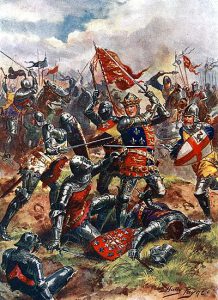 There is nothing more powerful than words that are well-written or well-uttered. They seep into our very consciousness, forming emotions, thoughts, and even images and concepts that are difficult to dispel. But sometimes, words mislead. Take William Shakespeare’s epic work on the famous Battle of Agincourt, found in Henry V. His language was masterful. Who has not felt lump in their throat and their eyes well up during the St. Crispin’s Day speech? “We few, we happy few, we band of brothers” resonates to this day as a motivational speech that neither George Patton nor Vince Lombardi could surpass. Who cannot fail to imagine the grizzled line of English longbowmen moving “once more unto the breach?” The Bard’s words have taken the story of Agincourt, where an outnumbered and desperate English force stood against the armed might of France and won, and immortalized their epic victory.
There is nothing more powerful than words that are well-written or well-uttered. They seep into our very consciousness, forming emotions, thoughts, and even images and concepts that are difficult to dispel. But sometimes, words mislead. Take William Shakespeare’s epic work on the famous Battle of Agincourt, found in Henry V. His language was masterful. Who has not felt lump in their throat and their eyes well up during the St. Crispin’s Day speech? “We few, we happy few, we band of brothers” resonates to this day as a motivational speech that neither George Patton nor Vince Lombardi could surpass. Who cannot fail to imagine the grizzled line of English longbowmen moving “once more unto the breach?” The Bard’s words have taken the story of Agincourt, where an outnumbered and desperate English force stood against the armed might of France and won, and immortalized their epic victory.
The popular understanding of Agincourt holds that a revolution in military affairs occurred that wet October day in 1415, when well-trained English yeomen archers armed with their formidable longbows—capable of ranging some 250 yards with rates of fire between 10-20 shots a minute—decimated the heavily armored mounted French knights who heretofore had dominated medieval battlefields. After a day of brutal fighting, the English force, estimated to be around 6,000-8,000 strong, outfought and essentially slaughtered the much larger French force, which was estimated around 25,000-35,000 men, including a large contingent of armored, mounted knights. The losses that day were astounding; the French suffered 7,000-10,000 dead, with another 1,500 nobles taken captive. The English suffered between 100 and 500 dead. The yeomen archer and his deadly longbow won a decisive victory.
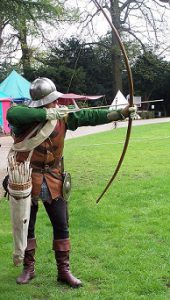 Military theorists and historians point to Agincourt as a decisive moment in history that forever ended the dominance of the mounted knight on the battlefield. The poor yeomen archers proved ascendant, and the day of the armored knight was over. Agincourt, or an Agincourt moment, is held to this day as a symbol of the failure to adapt, for a failure to perceive change, and as a failure to accept that technology can quickly surpass the status quo. As recently as this April, writing for the New York Times, Bret Stephens published an opinion piece entitled “The US Military: Like the French at Agincourt?” making this claim.
Military theorists and historians point to Agincourt as a decisive moment in history that forever ended the dominance of the mounted knight on the battlefield. The poor yeomen archers proved ascendant, and the day of the armored knight was over. Agincourt, or an Agincourt moment, is held to this day as a symbol of the failure to adapt, for a failure to perceive change, and as a failure to accept that technology can quickly surpass the status quo. As recently as this April, writing for the New York Times, Bret Stephens published an opinion piece entitled “The US Military: Like the French at Agincourt?” making this claim.
In demonstrating the relevance of Agincourt today, the subtitle of his piece notes “America risks a catastrophic defeat if it doesn’t radically change the way it thinks about war,” and proclaims “the logic here is the same one that decided the Battle of Agincourt, where the humble and effective English longbow made short work of the expensive and vulnerable French cavalry.” His logic holds that the tragedy of Agincourt is compounded because the French should have known better.
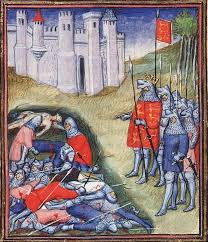 And he is correct in that assessment. The longbow was not a new revelation at Agincourt, but instead was the ultimate pink flamingo; indeed, a previous generation of French knights were similarly tormented by English longbowmen in the first part of the Hundred Years’ War at the Battles of Crecy (1346) and Poitiers (1356). Stephens argues that the contemporary U.S. military, like the French before them, is pouring money into exquisite systems that will soon be made obsolete by other low-tech, simpler systems. He references $13 billion aircraft carriers and $90 million fighter aircraft—the French knights of our day—as vulnerable to disposable swarms of intelligent machines, today’s longbow.
And he is correct in that assessment. The longbow was not a new revelation at Agincourt, but instead was the ultimate pink flamingo; indeed, a previous generation of French knights were similarly tormented by English longbowmen in the first part of the Hundred Years’ War at the Battles of Crecy (1346) and Poitiers (1356). Stephens argues that the contemporary U.S. military, like the French before them, is pouring money into exquisite systems that will soon be made obsolete by other low-tech, simpler systems. He references $13 billion aircraft carriers and $90 million fighter aircraft—the French knights of our day—as vulnerable to disposable swarms of intelligent machines, today’s longbow.

This is a powerful image when linked to Agincourt and definitely is a train of thought that needs to be accounted for in terms of defense planning and in terms of designing a future joint force. However, this logic, which is widespread among many futurists, should have an asterisk by it, as it misses a key point, which is perhaps understandable in light of the powerful mythology of Agincourt fostered by the transcendent words of Shakespeare; that in spite of what happened at Agincourt, the FRENCH WON THE WAR.
The English victory at Agincourt, it turns out, was not really much of a victory. Henry V’s army was so weakened—by poor logistics and disease—that it actually was forced to withdraw from the field after winning such a major victory. By the end of the month, Henry had withdrawn to Calais, his invasion of Normandy halted. He was able to turn his success at Agincourt into the Treaty of Troyes, which named him as the heir to the French throne, but this proved to be nothing more than a temporary truce. The English failed to capitalize on the advantage the longbow gave them and instead squandered an opportunity to conclude the war successfully.
 So how did the French prevail? I think there are three important lessons here that should be considered, particularly as the United States ponders the implications of a return to great power competition and conflict against peers or near peers.
So how did the French prevail? I think there are three important lessons here that should be considered, particularly as the United States ponders the implications of a return to great power competition and conflict against peers or near peers.
The first is that there is a continuum between competition, conflict, and return to competition that is an essential aspect of great power competition. Few great power conflicts end in the total defeat of one or the other. The Hundred Years’ War is likely more emblematic of the types of conflicts that will be waged in the near future, in the Era of Accelerated Human Progress and the Era of Contested Equality. The Hundred Years War was really a combination of several separate wars linked together by the inability of either side to compel a decisive victory; a period of competition, conflict, and return to competition that lasted for 116 years.

Although the English won many battles in the first phase of the war, their most important achievement was not the tactical success of the longbow, but instead was their ability to use other elements of national power in the competition phase to surround the French with enemies on three sides (England, Aquitaine, and Burgundy). For its part, the French had cultivated Scotland as an ally, posing a real and imagined threat to the English, but to secure final victory, the French would need to split England’s allies on the continent.
This was only made possible through a series of military victories. The Treaty of Troyes only remained in effect for six years, when the French again resumed the fight. The English responded with a renewed invasion, and in 1428 they besieged the French city of Orleans.
At this point, the second essential element of the French victory revealed itself; better leadership. Although the English possessed a number of fine 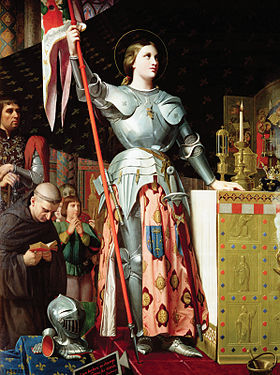 battle captains, it was the emergence of the most dynamic leader of the war, Joan of Arc, who made a significant difference. Her greatest feat did not lie in military organization, strategy, or tactics, but instead in an ability to inspire and unite the French. She arrived at Orleans just as the city was about to fall to the English and broke the siege. She then led a highly effective campaign in the Loire Valley which beat the English in several key fights, including at Patay, in June 1429.
battle captains, it was the emergence of the most dynamic leader of the war, Joan of Arc, who made a significant difference. Her greatest feat did not lie in military organization, strategy, or tactics, but instead in an ability to inspire and unite the French. She arrived at Orleans just as the city was about to fall to the English and broke the siege. She then led a highly effective campaign in the Loire Valley which beat the English in several key fights, including at Patay, in June 1429.
Patay, an often forgotten battle, is relevant because it was the antithesis to Agincourt. At Patay, a force of armored French knights, not hampered by rain and mud as they were at Agincourt, charged into the ranks of the helpless English bowmen. They relied on better battlefield awareness, better intelligence, and well concealed movement to maneuver to a point where their knights could effectively charge. Some 2,500 English—mostly longbowmen—were killed for the loss of only 100 French. With this victory, the French demonstrated that strong leadership and an appreciation of their enemy’s capabilities could in fact overcome the tactical strengths wrought by the longbow.
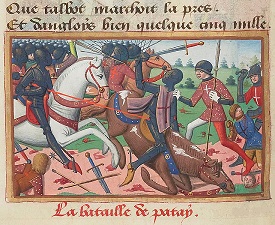
The French successes in the Loire Valley led to the strengthening of the overall French position. In spite of Joan’s capture and execution, Charles VII was crowned king in 1429, and he was able to completely reverse the diplomatic situation. His most important success arguably came not on the battlefield, but with the 1435 Treaty of Arras, where he was able to cut a diplomatic deal with Burgundy, who accepted Charles’ claim to the throne and abandoned the English. This allowed the French to embark on a final campaign, which in turn revealed the third and final factor in France’s victory; an effective military modernization.
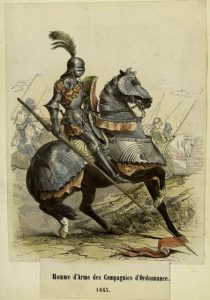
The French appeared to understand that the character of the war they were fighting was changing. It would be neither armed knights nor the English longbowmen that would determine final victory, but instead it would be a more professional, sophisticated, combined arms force equipped with effective artillery, that would finally prevail. The French reorganized their forces into Compagnies d’Ordonnance, combined arms units of heavy cavalry, archers, men-at-arms, and supporting units that consisted of about 600 men. By 1445, the French Army had 15 of these new formations, which gave them a more professional, well-organized force. Additionally, the French also quickly mastered and integrated the production of new and more sophisticated artillery into their force and were able to mass hundreds of guns to undertake sieges, the type of fight that would dominate the final phase of the war.
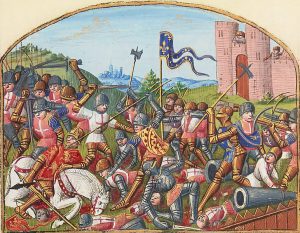
These organizational and technological innovations, matched by sound leadership and effective diplomacy, led to the final French victory. First, they captured Rouen in 1449, and then Formigny. By 1451, the French added Bordeaux and Bayonne to their victories, and finally, in the last great battle of the war, utterly defeated the English at Castillon in 1453. In this fight, it was the English, who launched an all-out assault against a French fortified camp equipped with cannon and archers, who suffered slaughter, losing 4,000 in the process.
The English hold over France was forever broken and by 1453 its only possession on the continent was the port of Calais. To protect its hard-earned victories, the French again mastered the return to the competition phase by using its diplomatic and economic power to help foster instability in England, which quickly descended into its own dynastic troubles with the Wars of the Roses. Although it suffered dramatically, the Hundred Years’ War solidified French rule and in many ways, was the springboard that launched France as a nation.
So what does this all mean for the U.S. Army of today? The most important lesson of Agincourt is that nothing is as simple as it seems. Yes, the English longbow was transcendent that day, as it was at Crecy and Poitiers 70 years prior. However, the era of the knight did not end that day. Armored knights remained relevant—if not at times dominant—for the rest of the war. In fact, armored cavalrymen would be part of a combined arms force that remained relevant throughout the Wars of the Roses, and really for another 100 years.
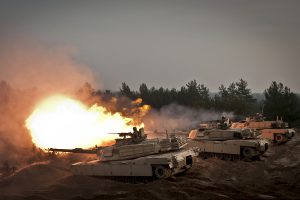 Agincourt, on its face, seems to offer an important lesson; the idea the expensive, exquisite force can be highly vulnerable to cheaper systems, particularly at range. We clearly do not wish to be the French at Agincourt; a force that ignored a brazen pink flamingo in its midst and was so stubborn and set in its ways that it underestimated its enemy and smashed its exquisite force against ranks of English archers on multiple occasions. They ignored their enemy’s stand-off capability, which is in some ways akin to the dilemma
Agincourt, on its face, seems to offer an important lesson; the idea the expensive, exquisite force can be highly vulnerable to cheaper systems, particularly at range. We clearly do not wish to be the French at Agincourt; a force that ignored a brazen pink flamingo in its midst and was so stubborn and set in its ways that it underestimated its enemy and smashed its exquisite force against ranks of English archers on multiple occasions. They ignored their enemy’s stand-off capability, which is in some ways akin to the dilemma 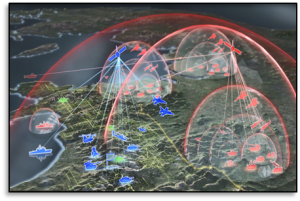 posed by the anti-access/area denial challenge to the U.S. Joint force today and in the future. The first step is accepting and understanding the problem, so that we do not ignore the pink flamingo in our midst; adversaries who can challenge us in multiple domains and along multiple axes at stand-off ranges.
posed by the anti-access/area denial challenge to the U.S. Joint force today and in the future. The first step is accepting and understanding the problem, so that we do not ignore the pink flamingo in our midst; adversaries who can challenge us in multiple domains and along multiple axes at stand-off ranges.
However, the more subtle lesson of Agincourt is that while we must try to avoid the arrogance and stubbornness of the French, we equally do not wish to emulate the English, who failed to parley their tactical advantage into any kind of real success, namely because they failed to understand the character of the war they were fighting or to effectively shape the transition between conflict and return to competition. This too is an important lesson, particularly as the U.S. Army is on the precipice of adding a variety of new high-tech systems to its ranks in the near future. The English teach us that technology and tactical advantage can create challenges for an adversary, but they do not, unto themselves, guarantee victory.
As the French finally demonstrated—although belatedly and after much suffering—tactical and technological advantages can be overcome. The French improved and modernized their own force with smart innovation in terms of technology (artillery) and organizational structures, and benefited from capable and inspired leadership. Finally, and arguably most importantly, they recognized that great power conflict requires more than a military 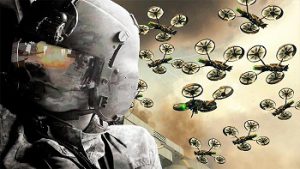 solution. I agree with Bret Stephens that the true risk the U.S. military faces is that we do not wish to recognize that our exquisite force is vulnerable to cheaper technology. So our task is to understand that key point and in turn make the Joint force capable of not only protecting itself against today’s longbows but also to effectively and creatively think about how to use our unique—and at times exquisite—capabilities to present dilemmas to our adversaries that translate into success.
solution. I agree with Bret Stephens that the true risk the U.S. military faces is that we do not wish to recognize that our exquisite force is vulnerable to cheaper technology. So our task is to understand that key point and in turn make the Joint force capable of not only protecting itself against today’s longbows but also to effectively and creatively think about how to use our unique—and at times exquisite—capabilities to present dilemmas to our adversaries that translate into success.
In a future where capabilities between peer and near-peers will be roughly equivalent, with specific advantages and characteristics held by each of the main competitors, but an overall rough equivalency balancing at the macro level, the weapons, equipment, and technology possessed by a nation will be important, but likely will not confer a war-winning advantage. Instead, leadership, innovation of ideas, sophisticated training, and a whole-of-government approach to competition and conflict matched by the smart and effective introduction of technology and organizational change will, as they did in 15th Century France, remain essential elements of success in a future conflict.
If you enjoyed this post, please see the following previous posts by Ian Sullivan:
– Making the Future More Personal: The Oft-Forgotten Human Driver in Future’s Analysis
– Lessons Learned in Assessing the Operational Environment
… as well as:
– The Changing Dynamics of Innovation
– Setting the Army for the Future (Parts I, II, and III)
– Winning Future Wars through Developing the Intellectual Component of Fighting Power: The Australian Army’s Approach to Professional Military Education by LTCOL Greg Colton, Australian Army
Ian Sullivan is the Assistant G-2, ISR and Futures, at Headquarters, TRADOC.

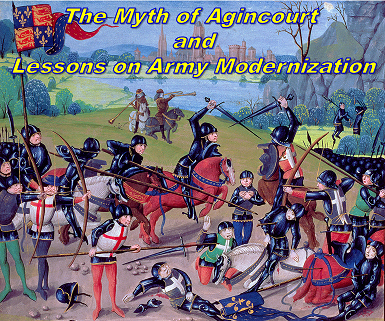


I enjoyed this article. There is indeed a great deal we can learn from historical battles. But “once more into the breach” is not in reference to Agincourt. That particular breach was the gap in the wall of Harfleur. Henry had the city of Harfleur under siege. He was encouraging his army to attack, even if they have to ‘close the wall with English dead’.
Once more unto the breach, dear friends, once more;
Or close the wall up with our English dead.
In peace there’s nothing so becomes a man
As modest stillness and humility:
But when the blast of war blows in our ears,
Then imitate the action of the tiger;
Stiffen the sinews, summon up the blood,
Disguise fair nature with hard-favour’d rage;